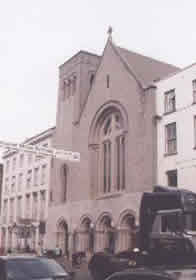
© Augustinian church
The present day Augustinians church is situated on O'Connell
Street in the City Centre. On the right as you enter the church there
is the old lintel stone that came from the order's first chapel in Limerick
at Fish Lane. The date 1633 can be seen on the stone along with the
letters I.H.S. and the symbol of the heart from the crest of the Augustinian
order.
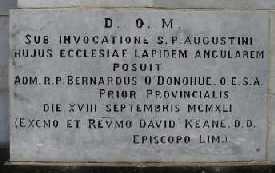
© Foundation stone in Augustinians Church
The O'Doherty family saved this stone in 1933 when the
buildings in Fish Lane were knocked for new houses. The stone was kept
in their stonecutting yard until two brothers Frank and Anthony McNamara
brought it to the attention of the Prior, Fr Vincent Lyons in 1961.
Fr Lyons bought the stone and in October 1962, it was inserted into
the wall of the church.
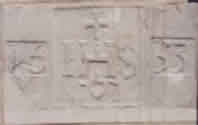
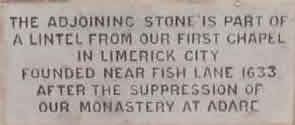
© Lintel stone in Augustinians church
In the porch of the church, there are two holy water fonts
from the church in Creagh Lane. These holy water fonts were in Creagh
Lane from 1823 until the present day church was opened in 1941. Inside
the church, there is a bookshop on the left and a Pastoral Centre on
the right. Also on the right is a painting of the Ascension by Thomas
Collopy, a Limerick man. This painting, which dates from 1782, originally
hung in the chapel in Creagh Lane.
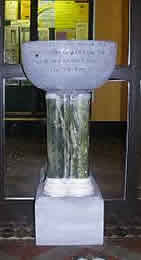
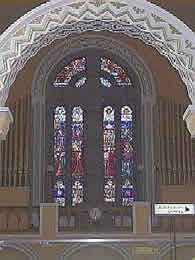
© One of the water fonts from the church in Creagh Lane
and Stained glass windows at back of Augustinians church
Above the main door of the church on O'Connell St., a
large stained glass window depicts scenes from the life of St Augustine.
The window shows (from left to right) his conversion, his consecration
as a Bishop, writing his confessions and the Transfiguring Experience
with his mother Monica. The window is dedicated to the memory of Fr
Joseph Hennessey who was the main driving force behind the building
of the church. Fr Hennessey died in 1941 before the church was completed
in 1942.
Above the four main sections of the stained glass windows,
are the symbols of the four Evangelists of the four Gospels which are
(from left to right) the bull (Luke), the man (Matthew), the eagle (John)
and the lion (Mark). Under the main stained glass sections of the window
are smaller sections depicting a book and quill, the Sacred Heart, the
crest of the Augustinian order, and the scales of justice.
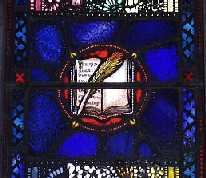
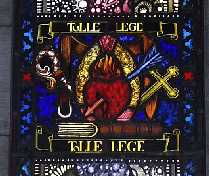
© Sections of Stained Glass Windows
The crest of the Augustinian Order depicts a heart on
fire, pierced by an arrow. This shows the passionate heart of St Augustine
and a heart that is open to the pain of joy of loving and the use of
love in the mission of an Augustinian. The open book in the crest represents
the Bible, which was the inspiration of St Augustine's life.
In 1998, the seats at the back of the church were removed
and an ornate screen was erected between the main body of the church
and this reception area.
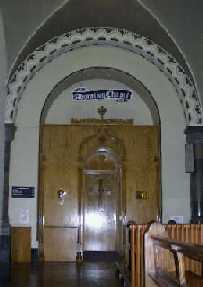
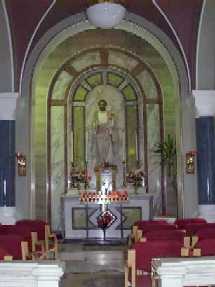
© Adoration chapel and Chapel to St Jude
Inside the church on the left, there is an Adoration chapel
that was opened by Bishop Donal Murray on 24 May 1998. There is also
a small chapel to St Jude, which was refurbished in 1998. There is a
shrine to St Nicholas of Tolentine, who was an Augustinian priest. There
is also a picture of Blessed William Tirry O.S.A. who lived in the 17th
century. At the top of the church, there is a statue of St Joseph and
there is an altar to the Sacred Heart.
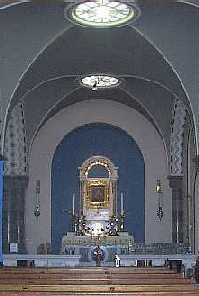
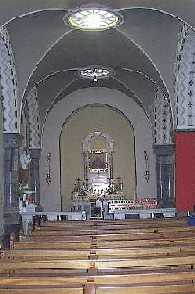
© Altar to Sacred Heart and Altar to Mother of Good Counsel
Inside the door on the right hand side of the church there
is a shrine to Blessed Padre Pio. Further on up the aisle there is a
statue of St Rita of Cascia. St Rita was an Augustinian sister who worked
with the sick. She is also known as the Saint of the Impossible. Next
there is an altar to St Monica that was donated by John and Joan Leonard.
To the right of the main altar, there is an altar to the Mother of Good
Counsel.
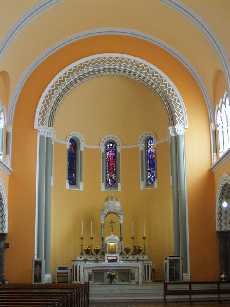
© Altar in Augustinians church
Over the main altar in the church there are five different
stained glass windows and they depict (from left to right) St Joseph,
St Monica, St Patrick, Mother & Child and St Augustine. In 1998
a silver chalice was discovered in a cylinder at the back of a safe
behind the main altar. According to the inscription, Dame Alice Nagle
donated it to the Augustinians Sisters in Dublin in 1750.
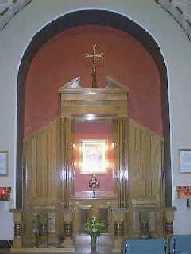
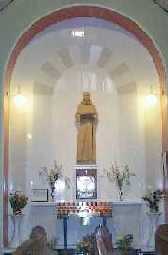
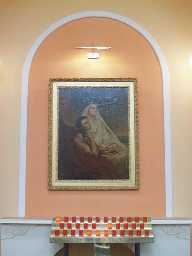
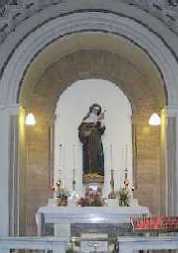
© Shrine to (From left to right) Padre Pio, St Nicholas, St Monica
and St Rita
The bells of the church are believed to be originally
from London. An elderly officer was living in retirement in London and
each evening he listened to the bells in a nearby church tower. Then
one evening, the bells did not ring and he discovered that the tower
was being knocked. So he bought the bells and moved to Ireland where
he built a replica of the tower. Fr Larry A. Doyle heard the story and
bought the bells for the new church in O'Connell St.. Each of the seven
bells was given a name of dedication and a prayer so that the chimes
of the bells may inspire the people who heard them.
The Augustinians have a graveyard in front of the Old
County Courthouse in Merchant's Quay.
As well as serving the spiritual needs of the community,
the Augustinians run a school for young people with special needs in
St Augustine's Hall.
The present priory is to the left of the church. It was
formally known as the 'Country Club', and came into the possession of
the order in 1946. This structure was built in 1825. The Augustinians
rented the ground floor of the premises in 1897 for £2,075 from
Dr Pryce Peacocke for a lease of 999 years. The Augustinians had first
option on the purchase of the premises and paid £15,000 for the
building in 1946.
The old priory, situated at 119 O'Connell St, was sold
to Mrs. Harrington for £7,800 to finance the purchase of the 'Country
Club' in December 1946. The priory was officially opened on May 25 1948.



Website by Lúnasa
Design